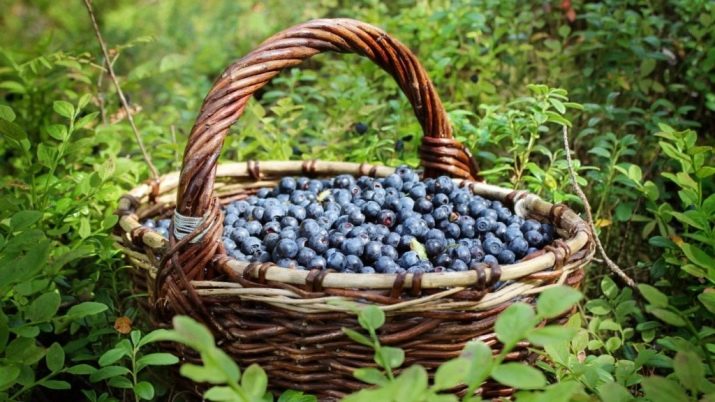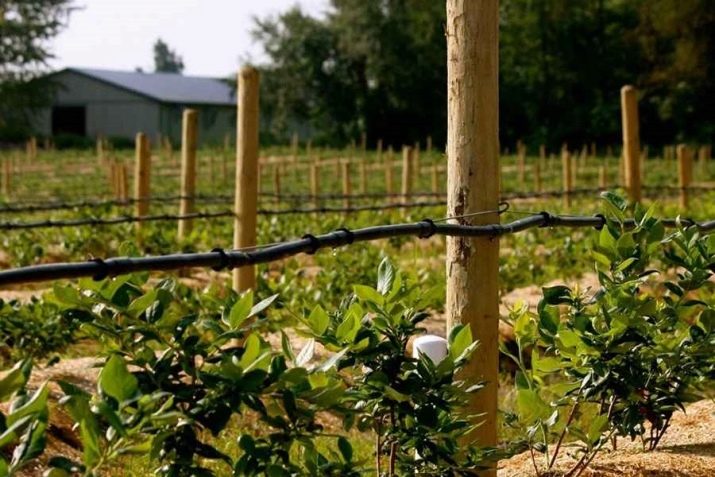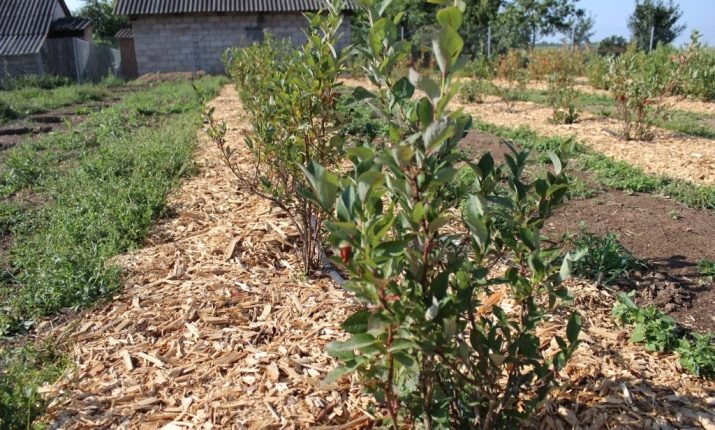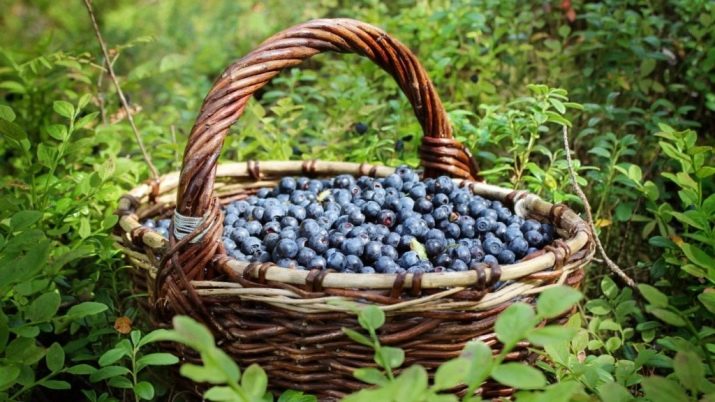Blueberries "Patriot": characteristics of the berries and tips on growing
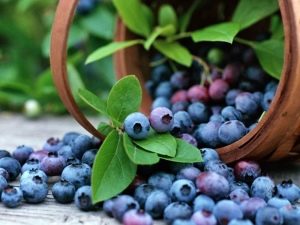
Blueberries are a tasty and healthy berry. Its fruits are used as food and medical field. Blueberries are grown in Europe, America and Austria. In Russia, berry can be found in the middle lane, tundra, southern regions. Among the variety of varieties of high-grade blueberries "Patriot".
Variety description
Experts consider North America to be the birthplace of the Patriot species. The plant was bred in 1952 in the city of Beltsville, located in Maryland. Specialists crossed varieties Earliblue, Dixi and Michigan. The plant turned out to be fruitful, it was distinguished by decorative features and tall. In 1976, seedlings of a new species began to be sold. The release date of the new variety coincided with the bicentennial since the unification of the states. Hence the name berry.
The above grade reaches a height of 1.8 meters. The branches are mostly flat and straight, sometimes there are a few branchy shoots. Mature leaves are painted dark green, young ones have a light reddish tint. The plant has excellent resistance to rotting roots, late blight and stem cancer.
Blueberries "Patriot" unpretentious to pollinators, soil composition and climatic conditions compared to most other varieties. For a rich result, choose a sour and loose soil. A warm place flooded with sunlight is the best location for a variety. The plant can be grown on the basis of industrial plantations and in private small gardens. Berries are harvested using special equipment or manually.
Features
Blueberries "Patriot" has its own characteristic differences.
- The flowering period falls on May.
- Fruits are harvested around mid-July and until the last month of summer.
- The berries have a round, slightly flattened form grouped together.
- The pulp of ripe berries has a pleasant aroma and sweet taste.
- The skin is a light blue shade, elastic and smooth.
- The average diameter of the berries reaches two millimeters.
- Regular fruiting.
Advantages, useful properties, disadvantages
A variety of blueberries "Patriot" has a lot of advantages, due to which the plant has gained immense popularity.
- Frost resistance Blueberry feels great in the cold season. The maximum index of frosts, which the variety is able to withstand, is -37 degrees.
- Disease resistance. Variety "Patriot" is a strong plant, it is not afraid of various diseases.
- Unpretentiousness to the composition of the soil. Drought or excessive moisture will not harm the shrub. Despite the high resistance, try to avoid such conditions.
- Ripe berries remain fresh for 10 days. At the same time they feel great in transit and storage.
- Comfortable fit. The direct form of the branches allows you to plant shrubs. This saves space in the garden. Even in such conditions, the berries will fully ripen, receiving the required amount of light.
Blueberries are known for healing properties. It is used to create many drugs, vitamin formulations and dietary supplements. Fruits have such a positive effect on the body:
- blood sugar level adjustment;
- diuretic effect;
- prevention of cardiovascular diseases;
- vision improvement;
- anti-sclerotic effect.
Before purchasing and planting plants should be familiar with the shortcomings. After disembarking, be patient.
To get a harvest, you must wait about 5-6 years. If the conditions for fruiting are excellent, the shrub will start to please berries earlier, but in a small amount.
Growing rules
Experienced gardeners note that the conditions for growing blueberries and the characteristics of care are different compared to growing raspberries, currants, blueberries, gooseberries and other shrubs. Simple recommendations will help to get a bountiful harvest and the shortest possible time:
- ideal soil acidity is pH 3.5–4.5;
- the treatment of diseases is not required;
- organic matter cannot be used as a fertilizer (manure, humus, animal dung);
- the ground should be loose and moderately moist.
Accommodation and landing time
Experts recommend planting blueberries in early spring. Until the period when buds begin to blossom. Autumn (after leaf fall) is also considered a favorable period. If you live in the area with a short fall, it is recommended to make a choice in favor of the first option.
The site where it is planned to plant the berry should be illuminated by the sun and warmed up carefully (in the warm season). In a region with strong gusts of wind, it is advisable to install additional protection in the form of a wall. Most often it is installed on the north side. A hedge would also be appropriate.
It is impossible to plant blueberries in a place where various crops that were fertilized with organic matter previously grew. Perennial herbs are ideal precursors.
Landing
It is worth taking note of a small instruction on planting blueberries.
- Pre-lower shrub roots in clear water for one hour.
- Arrange a place for the plant. The optimum depth is from 40 to 50 cm, diameter - about 1 m. The roots of the plant are superficial and grow in width.
- Prepare the substrate to fill the pit. To do this, mix the necessary components on the canvas or film. Thoroughly mix sand (river), pine sawdust and sour peat. If necessary, you can prepare the composition of the two components, mixing them in the same proportions (peat and sand or peat and sawdust).
- When filling the pit with a solution, do not tamp it strongly. Lush land is an important aspect for plant development.
- The young seedling is deepened into the soil by about 10 cm. The adult shrub is allowed to be buried up to 30 cm.
- In the center of the fossa, shape the onion with the size of the root system. Line the roots horizontally, straightening them to the side.
- Water the plant with acid. For 10 liters of fluid, 100 ml of vinegar 9% is needed.
- At the end, decorate the mulch with a height of 7 to 10 cm. To do this, use sawdust or peat.
Shrubs stored in a container before planting should be lowered in water containers. Next, you must carefully remove the plant and inspect the root system. If it is very tangled, you need to try to straighten the roots as much as possible and only then begin transplanting to the site.
Watering
Blueberries can survive a minor drought, but they are not worth the risk. If on the territory of the site pass groundwater at a distance of about half a meter from the surface, irrigation will have to be done twice a week. The dosage is 2 winds per shrub. Gardeners are advised to divide the watering in two parts (morning and evening).
In the absence of the ability to carry out watering periodically, you can install drip irrigation system. It will provide regular hydration. In hot conditions it is recommended to water the leaves. Experts advise to listen to general recommendations, but often the irrigation regime is disturbed by weather conditions. In addition, the frequency and volume of watering is significantly influenced by the size of the shrub, the thickness of the planting fossa. Keep in mind that the microclimate can change dramatically and often.
When watering, use a watering can with a strainer, this will prevent erosion of the surface soil. Use water with acid once a week. Lemon juice, vinegar or citric acid can be added to the liquid.
Gardeners recommendations
When watering watch for water absorption. The liquid must quickly fill the soil, penetrating deep into. If it stagnates on the surface, the soil is oversaturated. Check it out is easy. Enough to squeeze a lump of soil in your palm. Drops denote overwetting.
The mulch will help fix the problem. Use less water next time. Adjust the amount of water, taking into account changes in the weather.
Experienced gardeners equip wells, installing waterproof walls. You can use barrels. This is done in order to protect the roots from soil with insufficient or high acidity. In this case, you must carefully monitor the soil moisture. Stagnant water can lead to rotting of the roots and the destruction of the shrub.
Priming
The soil for growing blueberries needs a special approach. In the period of berry expansion, it is necessary to gradually increase the planting hole. It is necessary to drift the groove adjacent around the circumference, and also to make the soil acidic. During work, act carefully so as not to damage the root system. The adult bush of a grade of "Patriot" occupies a site, with a diameter of 1,5 meters.
At a depth of 3 cm around the bush can not chop weeds or loosen the ground. The roots of the plant are located close to the surface of the earth and almost do not recover when damaged. Add mulch periodically. It is able to acidify the earth a little, retains moisture and prevents the growth of weeds.
Top dressing
Fertilizers for this variety must contain acids. Nitrogen baits are recommended for use. They are used by three backs per season. The interval is twice a week. Start feeding - March, the end - the beginning of July. It is recommended to use different formulations as feed.
- Ammonium sulphate solution. Dilute a teaspoon to 10 liters of liquid.
- Infusions and decoctions and herbs containing acid. Suitable kislitsa, rhubarb or sorrel. The plant is poured with water and insist for two days.
- Mulch, consisting of the bark of pine, spruce and other coniferous varieties.
- Ready liquid dressing. The dose of use depends on the capacity of the soil. Approximate dosage is about 7 liters per adult bush.
The easiest way to properly fertilize a plant is to purchase a ready-made formulation, designed for heather varieties or blueberries.
Plant formation
The above variety of berries can boast of active development and rapid growth. However, it is prone to thickening. 3-4 years after planting it is necessary to start pruning the plant. It should remove loose, dry, broken, curved and frozen branches. The main task is to leave only strong and healthy shoots that will bear fruit. Try to remove branches evenly from all sides to get a neat and beautiful shrub.
After 2 years, the trimming and thinning procedure should be carried out more carefully. It is necessary to delete old branches. 10-15 years after planting, the yield of the berries will fall, the fruits themselves will decrease in size. To return the plant to its former fecundity, it is necessary to completely remove the bush, leaving the root system.
As a result, a sharp and active growth of new branches will be provoked. 2 years after such intensive therapy, large and tasty berries will begin to appear on the shoots.
If properly care for the plant, the shrub will live and delight the crop over the years. Pruning is recommended in early spring (before the sap flow process).
Wintering
Blueberries can survive severe frosts, but in the case of severe and prolonged winters, the shrub must be protected. Otherwise, part of the branches (up to the level of snow cover) may completely freeze out. In order for the shrub not to suffer in front of strong frosts, it is necessary to cover the soil and the lower part of the plant with a spruce. So the plant will be protected from small rodents, and the root system will be covered from frost. If the shrub is young and low, you can close it completely. To do this, use any breathing material.
When the branches are more than a meter high, press them to the ground and protect them with breathable material.
Harvest
Ripe berries are harvested in the middle of summer. The fruits ripen with different frequency, for this reason, the harvest is collected in several visits. At the beginning of the fruitful season, the berries are large, after the diameter begins to shred.For two weeks, the berries remain fresh in a tight package under certain conditions (in the refrigerator). The first collection is recommended to eat. The optimum productivity of one bush totals 7 kg.
Reviews
Many summer residents rated this variety of blueberry at the highest level due to high yields. Caring for a plant has its own characteristics, but it can not be called capricious. Landscape designers use Patriot blueberry to create expressive living compositions. It should be noted the benefits of berries and their excellent taste.. The fruits are used for cooking, preserves, tinctures. They are an excellent filling for home baking.
For some tips on planting blueberries, see below.






